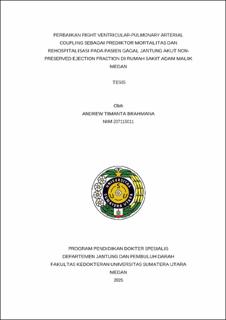Perbaikan Right Ventricular Pulmonary Arterial Coupling sebagai Prediktor Mortalitas dan Rehospitalisasi pada Pasien Gagal Jantung Akut Nonpreserved Ejection Fraction di Rumah Sakit Adam Malik Medan
Right Ventricular–Pulmonary Arterial Coupling Improvement as Predictor of Mortality and Rehospitalization in Patients with Acute Heart Failure with Non-Preserved Ejection Fraction at Adam Malik General Hospital, Medan

Date
2025Author
Brahmana, Andrew Timanta
Advisor(s)
Nasution, Ali Nafiah
Raynaldo, Abdul Halim
Metadata
Show full item recordAbstract
Objective:
To evaluate the improvement in right ventricular–pulmonary artery (RV–PA) coupling;
measured by the tricuspid annular plane systolic excursion/pulmonary artery systolic
pressure (TAPSE/PASP), during hospitalization as a predictor of mortality and
rehospitalization within six months after treatment in patients with acute heart failure
(AHF) with non-preserved ejection fraction (non-HFpEF) at Adam Malik General
Hospital, Medan.
Methods:
This study was an analytical study with a retrospective cohort design involving patients
with AHF non-HFpEF treated at Adam Malik General Hospital between January 2023
and January 2025. RV–PA coupling was assessed using the TAPSE/PASP ratio obtained
through transthoracic echocardiography (TTE) at admission and discharge. Statistical
analyses were conducted to evaluate the association between changes in the RV–PA
coupling and six-month outcomes of mortality and rehospitalization post-discharge.
Results:
A total of 62 patients were included, predominantly 48 patients (77.4%) were male, with
a mean age of 60 years. Hypertension was the most common comorbidity in 41 patients
(66.1%), and 48 patients (77.4%) of subjects had a sinus rhythm. The most frequently
observed AHF phenotype was acute decompensated heart failure (ADHF) at 30 patients
(48.4%). At follow-up, 32 patients (51.6%) experienced mortality or rehospitalization
within six months after discharge. Analysis showed that increased TAPSE/PASP, with
increase of TAPSE of ≥1 mm or just overall with cutoff 0.39 and 0.53, respectively, was
significantly associated with lower rates of 6 months post mortality or rehospitalization.
However, multivariate analysis revealed RV-PA coupling improvement as an
independent factor in mortality or rehospitalization, with no significant impact of
supportive therapy during hospitalization or guideline-directed medical therapy discharge
on (GDMT <3 out of 4) on these outcomes.
Conclusion:
Improvement of RV–PA coupling during hospitalization may serve as a substantial noninvasive
predictor of mortality and rehospitalization for 6 months in patients with AHF
non-HFpEF. This measurement could be broadly applied in clinical practice to improve
risk stratification and guide patient management.
Collections
- Master Theses [107]
